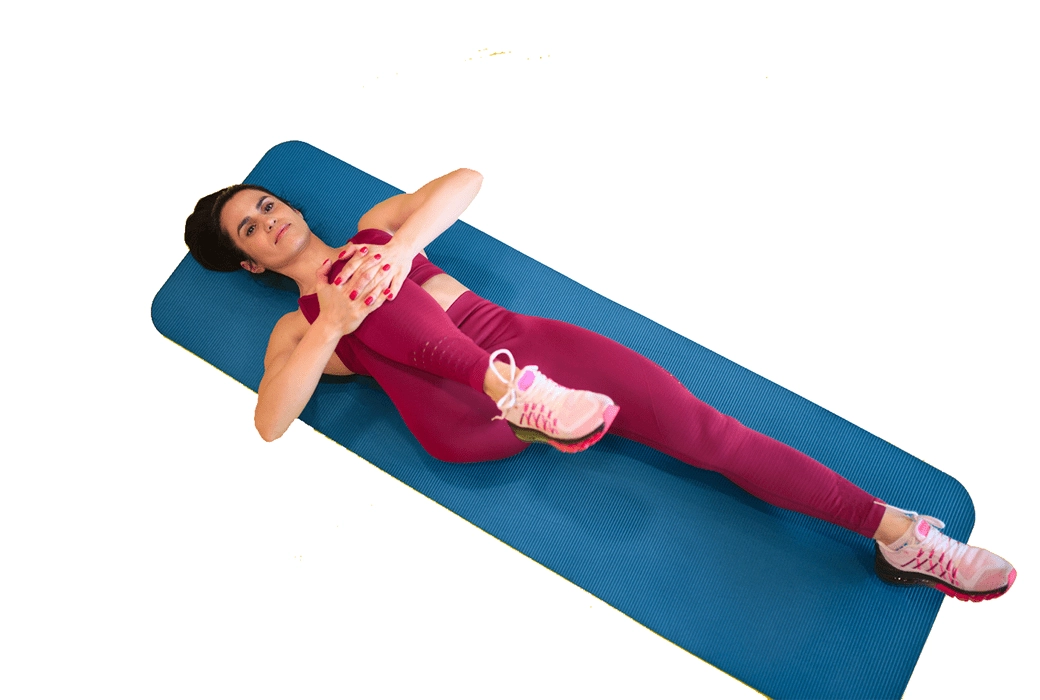Hip flexors are a common complaint among people with all different types of lifestyles. Sitting for long periods is often to blame, but extremely active people can suffer from tight hip flexors, too. Here’s how to test if your hip flexors are tight:
- Lie on your back on a table or bench. Let your lower legs hang off the side at the knees.
- Pull one knee up to your chest while keeping your head, shoulders, back, and hips in contact with the table.
- Your other leg will remain in contact with the table, your knee at a 90-degree angle if your hip flexors aren’t tight.
- If they are tight, your other leg will come up from the table, causing your knee to come out of the 90-degree angle.
- Try on alternate sides, because one hip flexor may be tighter than the other.
It helps to have another person present to take a picture or help you do this slowly.
But what if your hip flexors aren’t tight and you still feel like they are? The most common culprit is weak hip flexors. Read on to discover all about tight and weak hip flexors, and what you can do about them.
“Why Are My Hip Flexors So Tight?”
This is a common question, and a good one. After all, if you can figure out what’s making them so tight, you can make changes to remedy the situation. But this varies from person to person. Some people are more susceptible to tight hip flexors than others. But, here are some common reasons why people experience tight hip flexors:
- Prolonged sitting – Shortens and weakens the flexors.
- A tipped pelvis (anterior or posterior pelvic tilt).
- Uneven hips – Usually cause tightness on one side.
- Poor posture – Standing or leaning on one hip.
- Sleeping on one side at night.
- Running or exercising without regularly stretching the hip flexors.
Tight Hip Flexor Symptoms
Now that you know the potential causes, let’s go over the most common symptoms. Many people are surprised by how tight hip flexors can affect other parts of the body. This is because there are many different muscles in the hip flexor family. Mostly they help to lift the leg at the hip, but they also help stabilize the spine and can even affect the neck and shoulder area.
- Tightness in the upper groin/hip area.
- Pain or tightness in the lower back when standing.
- Pain or tightness in the neck.
- Trouble standing up straight.
- Pain or tightness in the glutes.
- Tight hamstrings.
How to Release Tight Hips?
The test mentioned above is a great way to determine if you have tight hip flexors. Before you attempt to stretch your hip flexors, it’s key that you determine if your hip flexors are tight or weak. To reiterate the Thomas Test:
- Lie on your back on a table or bench. Let your lower legs hang off the side at the knees.
- Pull one knee up to your chest while keeping your head, shoulders, back, and hips in contact with the table.
- Your other leg will remain in contact with the table, your knee at a 90-degree angle if your hip flexors aren’t tight.
- If they are tight, your other leg will come up from the table, causing your knee to come out of the 90-degree angle.
- Try on alternate sides, because one hip flexor may be tighter than the other.
If you don’t have tight hip flexors, stretching them will not do you any good. Instead, you’ll need to strengthen them. Many people confuse tight hip flexors with weak ones and are discouraged when they don’t find relief after stretching them. If you determine that you have weak hip flexors, we have a section on strengthening them below.
Stretches for Tight Hip Flexors
Here are some easy stretches you can do for your hip flexors.

Butterfly Stretch
- Sit on the floor with the heels and toes of your feet pressed together.
- The weight of your knees as they open up and move toward the floor will stretch your hips.
- For more of a stretch, you can gently press down on the inside of your knees.
- Hold for 30 seconds to one minute.
Chair Stretch
- While sitting in a chair, raise one leg and place your ankle on your opposite knee.
- Straighten your back and then hinge your torso forward. You should feel a stretch in the hip and glute.
- Hold for one minute and then switch legs to repeat.
Kneeling Hip Flexor Stretch
- Kneel down with one leg bent at 90-degrees in front of you and the other at 90-degrees underneath you.
- Keep your back straight, squeeze your glutes, and tuck your pelvis forward.
- Maintaining this position, lean forward gently into your forward leg. You should start to feel the stretch along the hip and front of the leg underneath you.
- Hold for 15 to 30 seconds, going as far as is comfortable for you.
- Repeat 3 to 5 times.
Any of these stretches can be done 2 to 4 times throughout the day to keep your flexors from getting tight.
Chiropractic to Loosen Tight Hips
If you are dealing with pain in your hips when stretching or sitting, you may be experiencing something other than tight hip flexors. Or, something in addition to tight hip flexors. If anything you’re doing, like exercising or stretching, causes you pain, it’s important to stop what you’re doing. At this point, it’s a good idea to see a chiropractor for a possible hip adjustment.
You may also consider seeing a chiropractor if the stretches above don’t give you relief from the feeling of tightness in your hips. Many people think that chiropractors deal only with the back, but that’s not true at all. In fact, chiropractors specialize in the entire musculoskeletal system. And tight or painful hips are one thing they deal with a lot. So, seeing a chiropractor may get you the relief you need and set you on the course to pain and discomfort-free hips.
Chiropractic Massage for Tight Hips
Aside from a hip adjustment, chiropractors use other modalities like massage therapy for relieving pain and stiffness from tight hips. Many patients find that they get the most relief from a massage after an adjustment, while others prefer to receive a massage before the adjustment. Either way, the ultimate goal is to relieve pain and discomfort while getting to the root of the problem.
Tight Hip Flexors Cracking
One less common issue with hip flexors is cracking or popping during activity. People often experience this while they’re exercising or running, and it’s usually caused by a tendon or muscle sliding over bone.
While it may seem like stretching is the best idea for this, that’s not always the case. Unfortunately, it’s hard to tell what is causing the cracking without seeing a professional. In some cases, it could be gas escaping the hip joint, much like what happens when you crack your back.
In others, it’s an issue that needs to be addressed by strengthening and massaging the muscle or tendon responsible.
Strengthening Weak Hip Flexors
For those of you who have weak hip flexors causing your discomfort, here are a few exercises you can do:
Single-Leg Stance
- Stand on one leg while keeping the thigh of the other leg lifted parallel with the ground and the knee at 90-degrees.
- Hold for 30 seconds before switching sides.
- Repeat 6 to 8 times.
Knee Raises
- Lift each knee as high as possible quickly but under control in alternating movements.
- Continue this for 30 to 60 seconds.
- Repeat 3 to 5 times.
Straight-Leg Hip Flexion
- Secure one end of a resistance band around a sturdy object behind you. Place the other end around your high ankle or low shin.
- Standing straight and facing directly away from the secure object behind you, move your leg out in front of you, keeping it straight.
- Hold for 3 to 5 seconds at the place of highest resistance.
- Move your leg back in line with your other one.
- Repeat 8 to 10 times on each leg for 3 sets.









